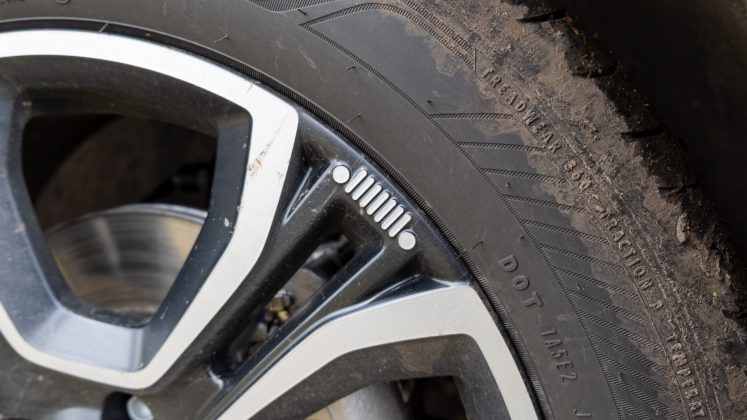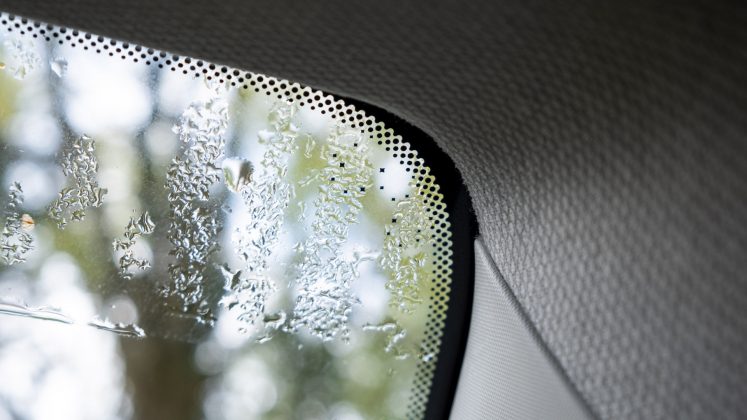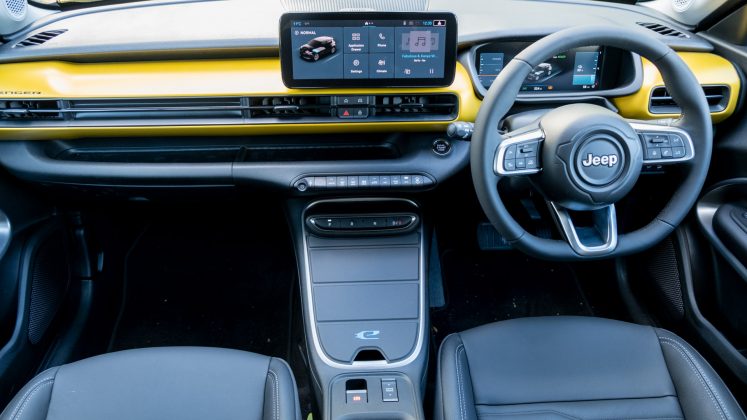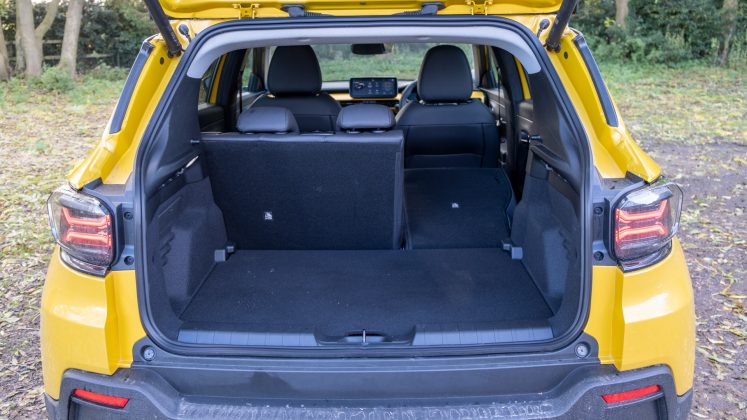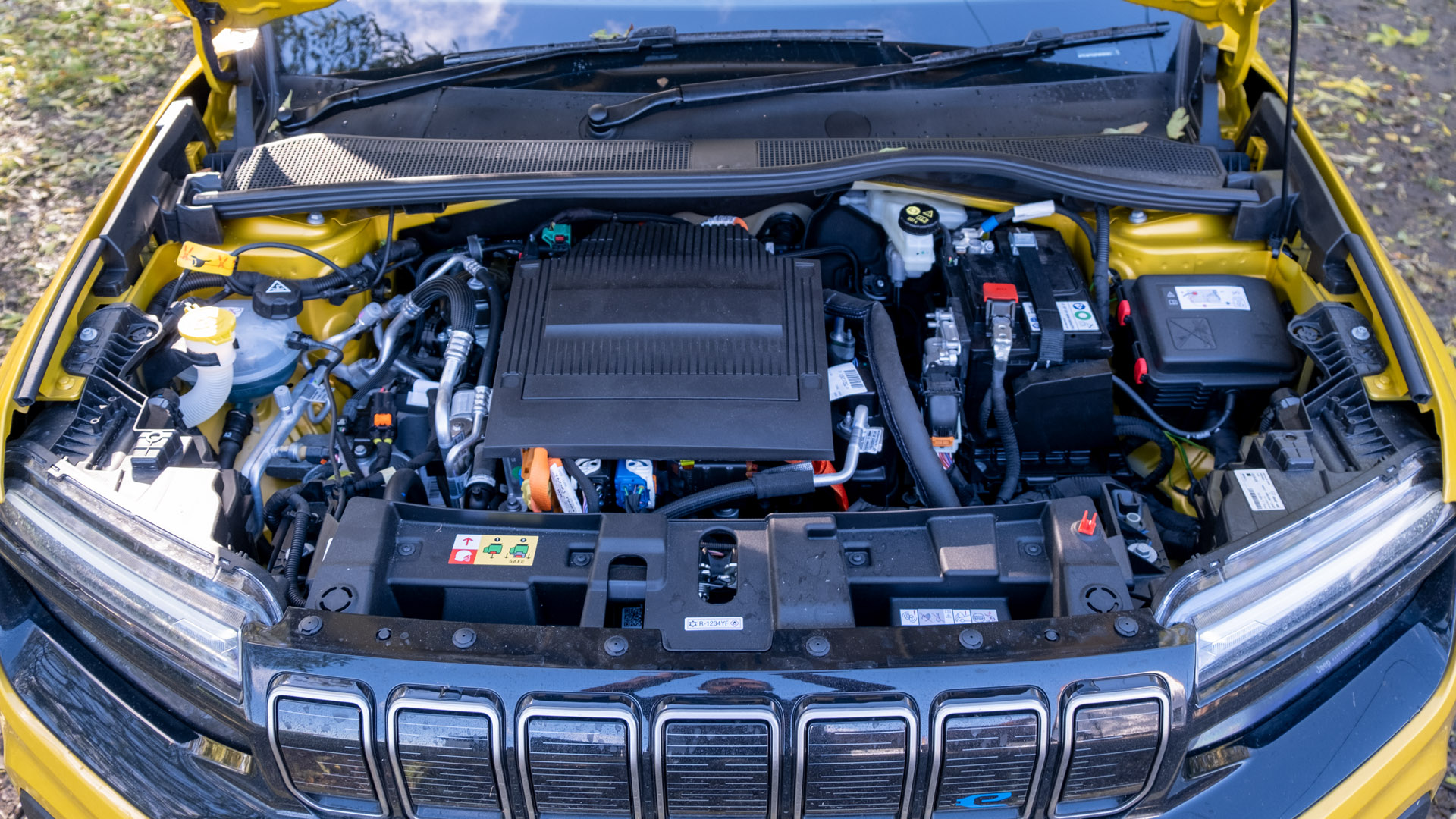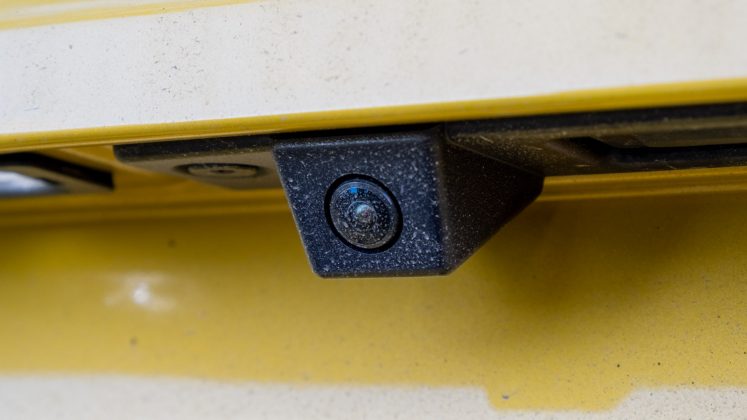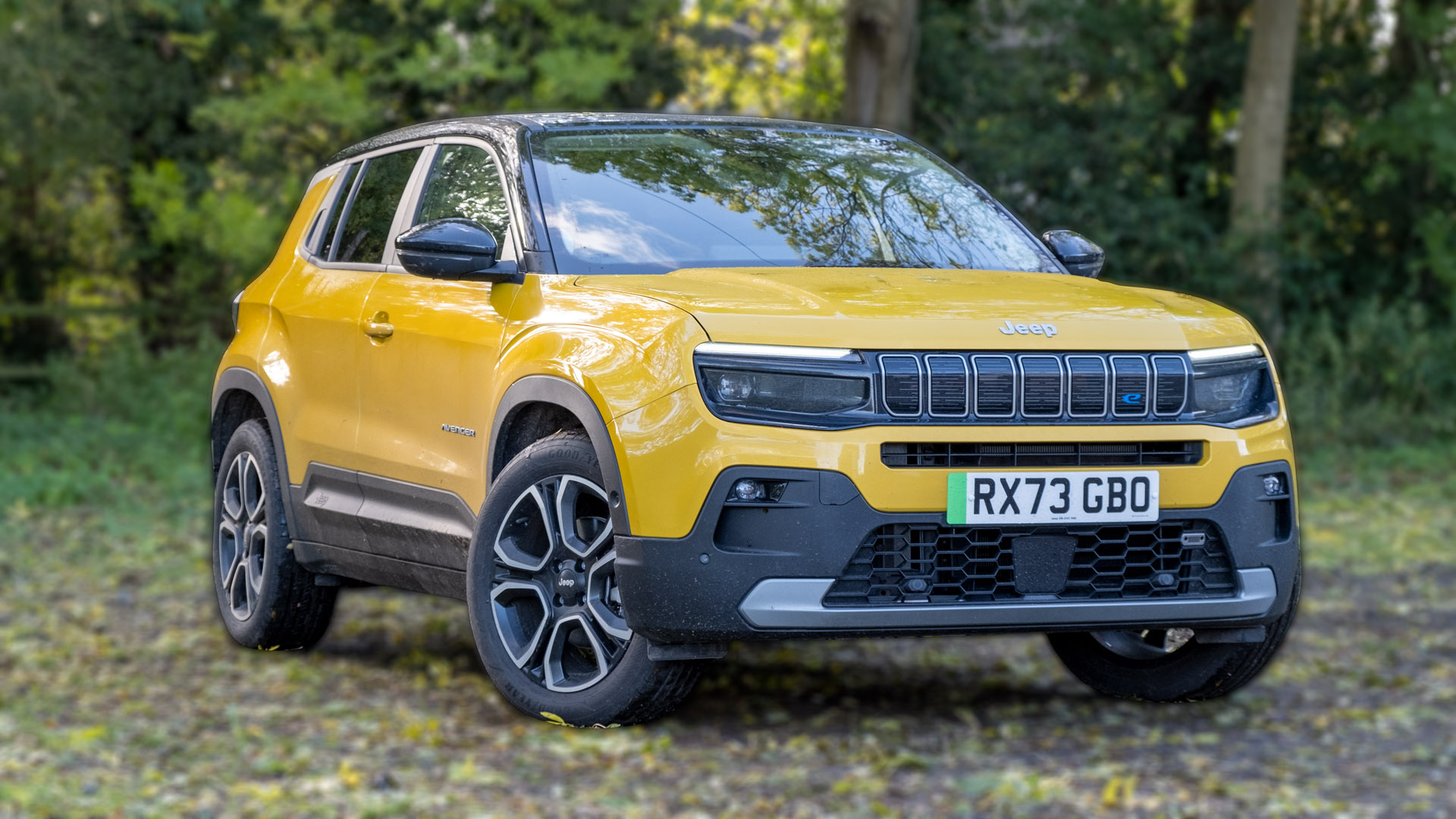The Jeep Avenger is the manufacturer’s first foray into the fully electric market. It’s aiming to appeal to a different crowd, with it being a small-sized SUV; quite different from the extreme off-roaders the automaker is renowned for producing. To further emphasise the point, the Avenger is solely available with a front-wheel drive (FWD) configuration – at least at the time of writing, as a 4xe (four-wheel drive) model is touted to come out at a later date.
If you’d prefer to watch a review of the Jeep Avenger, head on over to our YouTube channel.
Jeep Avenger price & competition
Despite its limitations, the all-electric Avenger is available in three trims: Longitude from £35,700, Altitude from £37,400 and Summit from £39,600. All models come with the same 54 kWh battery pack and have a single front-mounted motor that outputs 115 kW (154 hp) of power and 260 Nm of torque. Note, since its release, the Avenger is now also available with a petrol engine, however, in this review, we’ll be concentrating on the all-electric model.
A breakdown of the trims can be found below (click to expand):
Find the best Jeep Avenger deals
As for the competition, you have quite a few all-electric SUVs to choose from, such as: the Fiat 600e from £29,995; MG ZS EV from £30,495; Citroen e-C4 from £30,569; Citroen e-C4 X from £31,610; Kia Soul EV from £32,875; Hyundai Kona Electric from £34,995; Peugeot e-2008 from £36,500; Kia Niro EV ‘2 64’ from £37,325; Vauxhall Mokka-e from £37,610; Skoda Enyaq iV from £40,585; Volkswagen ID.4 from £42,640; Hyundai Ioniq 5 from £43,445; BMW iX1 from £44,560; Tesla Model Y from £44,990; Kia EV6 from £45,275; and the Audi Q4 40 e-tron from £50,745. You’ve also got the MG5 EV, an all-electric estate that starts from £30,995, and the Smart #1, a crossover that starts from £31,950.
Read next: Kia Niro EV review: An upgraded e-Niro?
Jeep Avenger exterior review
From the exterior, the Avenger looks the part, with it having Jeep’s DNA written all over it. The frontal grille, which is covered in the all-electric model, stylishly integrates itself with the slender headlights. From the side, 16” alloys come in fitted with the Longitude trim, 17” in the Altitude and 18” in the top-spec Summit model. The latter has a privacy glass too, while the integrated door handles on the rear doors feature across the entire trim range. As for the rear, it has a fitted look, with the on-brand taillights completing its profile.
In terms of your colour options, ‘Ruby’ comes as standard on all models, while the pastel ‘Snow’, ‘Volcano’, and metallic ‘Granite’, ‘Lake’, ‘Stone’ and pictured ‘Sun’ cost an additional £700 in the Longitude and Altitude trims. A bi-colour finish in the aforementioned colours is also available for £1,100 in the Altitude and Summit trims; the latter model is otherwise only available with the £700 ‘Volcano’ finish.
Those with a keen attention to detail will notice that Jeep has integrated a few Easter Eggs around the vehicle; a mini metal grille at the front, GPS coordinates on the bumper, the vehicle’s front profile on each alloy and a small ladybird on the roof.
Read next: Volkswagen ID.5 review: Germany’s best electric SUV?
Jeep Avenger interior review
The Easter Eggs continue within the cabin, with a majority of them located on the front and rear windows; a Jeep emblem can also be found on the outer edge of the dashboard. The pictured yellow dashboard costs an additional £150, which helps spruce up the interior design. The vehicle’s cabin has a nice look to it, however, won’t compete with more expensive alternatives.
The use of technology is also rather impressive. As standard, there’s a 10.25” 720p HD centre touchscreen display, which is both responsive and intuitively laid out with simple menus. Better still, Android Auto and Apple CarPlay are both supported over a wired and wireless connection.
These third-party mobile operating systems also feed through turn-based navigation data to the driver’s display, which is always appreciated. A 7” instrument cluster features in the entry-level model, while in the others you’ll find the pictured 10.25” display instead. Note, the larger display features as part of a £1,000 pack in the Longitude trim.
It is a shame, however, that there are no means of adding a Head-Up Display (HUD). Equally, there is no way of upgrading the six-speaker audio system, which will come as a disappointment to audiophiles as the configuration doesn’t perform well across the sound frequency range. You can hear how it performs by watching our dedicated audio review on YouTube.
Should you want to attain the utmost audio fidelity, you’ll want to plug in your smartphone to the infotainment system. The USB Type-A port found underneath the iPad-like cover, allows you to connect up to the car, while the Type-C port and 12V socket provide charge only. A singular USB Type-C port can also be found at the rear of the centre console in the Altitude trim and above, while in the top-spec Summit trim, you’ll also find a wireless smartphone charger.
Read next: Kia EV6 review: The Hyundai Ioniq 5 alternative
Jeep Avenger storage review
This brings us to storage, which is a bit limited due to poor optimisation. The glove box hasn’t been adapted for right-hand drive vehicles, the centre console is rather narrow while the front door bins have limited space. At the rear, it’s even worse, as there are no door bins or even a pull-down armrest.
You’re also constrained for space at the back of the vehicle, with its boot providing 355 litres of capacity and with the seats down, this figure extends up to only 1,053 litres.
To put this into context, here’s how it compares to its SUV rivals: Tesla Model Y (854/2,100 litres); Skoda Enyaq iV (585/1,710 litres); VW ID.5 (549/1,561 litres); VW ID.4 (543/1,575 litres); Hyundai Ioniq 5 (520/1,587 litres); Audi Q4 e-tron (520/1,490 litres); Citroen e-C4 X (510/1,360 litres); Kia EV6 (490/1,300 litres); MG ZS EV (448/1,375 litres); Kia Niro EV (475/1,392 litres); Peugeot e-2008 (434/1,467 litres); Mercedes EQA (340/1,320 litres); Kia Soul EV (315/1,339 litres); Citroen e-C4 (380/1,250 litres); Hyundai Kona Electric (332/1,114 litres); Vauxhall Mokka-e (310/1,060 litres). As for the MG5 EV estate, it offers 479 and 1,367 litres, respectively.
Indeed, it sits towards the lower end of the scale, even when compared with smaller-sized hatchbacks, such as: VW ID.3/Cupra Born (385/1,267 litres); MG4 EV (363/1,177 litres); Smart #1 (411-976 litres); and the GWM Ora Funky Cat (228/858 litres).
When it comes to convenience, there’s an electric tailgate in the Altitude trim and above. However, there’s a rather annoying beeping sound that can be heard each time you operate the boot. Thankfully, you have that hatchback design and a large underfloor compartment, which can be used to store your charging cables. The rear seats have a 60:40 design, which means there’s no integrated ski latch. Unfortunately, there are no seatbelt runners nor a compartment at the front of the vehicle (often referred to as a frunk).
Read next: Skoda Enyaq iV review: The Volkswagen ID.4 alternative
Jeep Avenger comfort review
There’s a further lack of optimisation within the cabin, with a nonsensical transmission tunnel present at the rear of the cabin; disappointing, given that it’s a fully electric vehicle. The result is that the rear middle occupant will be left in slightly more discomfort on longer journeys. With that said, rear legroom is quite limited anyway; 6-foot (180cm) individuals will feel henned in. On the other hand, headroom is good both at the front and rear of the cabin, with the main four seats being quite accommodating.
The front seats have 6-way manual controls as standard, but for an additional £1,200 one can add power leather seats instead. In the Summit trim, the front seats are heated, while a glass sunroof costs £700.
As for cabin noise, there’s a bit of road noise that can be heard from the tyres and wind noise deflecting off the A-pillars. However, there’s low-end resonance that can be heard when traversing uneven terrain or when you’re on the motorway. Quite surprising, as the other near-identical vehicles from the Stellantis Group (ie. Vauxhall Mokka-e, Peugeot e-2008 and Citroen e-C4), didn’t experience such an issue.
Read next: Citroen e-C4 review: Most comfortable SUV?
Jeep Avenger performance review
It’s also rather disappointing that the Jeep Avenger has a stiffened suspension setup, which results in a slightly uncomfortable driving experience when pottering around town. Potholes, speed bumps and anomalies aren’t absorbed. While it’s not as harsh as the likes of the MG ZS EV and Smart #1, it’s not as soft as the vast majority of its competitors and nowhere near as soft as the floaty-like suspension systems of the Citroen e-C4 and e-C4 X.
By comparison, however, the Jeep Avenger feels slightly more engaging to drive, with the vehicle not suffering from too much body roll and providing a good sense of connection with the front axle. Granted, it won’t compete with sportier and more expensive alternatives but at this price point, this little SUV is fun to throw around winding country roads.
This brings us to performance, which depending on the selected drive mode, you’ll have different levels of power and torque from its front-mounted motor: Eco gives you 60 kW (82 hp) and 180 Nm of torque; Normal dispatches 80 kW (109 hp) and 220 Nm of torque, while Sport mode provides the full 115 kW (154 hp) of power and 260 Nm of torque.
In Sport mode, we had it tested using Racelogic’s Performance Box Touch, from 0-20mph in 2.44 seconds, 0-30mph in 3.68 seconds, 0-60mph in 8.8 seconds, 50-70mph in 4.55 seconds and peak acceleration of 0.39g. Top speed is limited to 93mph. These aren’t exactly electrifying results, but will suffice for the vast majority of consumers.
However, the cause for concern is that the Jeep Avenger is solely available as a front-wheel drive (FWD) vehicle. Therefore, it’s not a suitable off-roader unlike the Subaru Solterra or other all-wheel drive (AWD) electric SUVs. Sure enough, there are some off-roading competencies, such as its wading depth of 230mm, plastic wheel arches that’ll help preserve its paint and a few off-road modes, but it still doesn’t entice much confidence when traversing challenging terrain.
TotallyEV understands that there is a 4xe (four-wheel drive) model touted to come out at a later date, but at the time of writing, it’s not available.
Find the best Jeep Avenger deals
Another thing to consider, especially if you want to go cross-country is its electric range. Here, there is a 54 kWh battery pack with a heat pump that comes fitted as standard across the trim range. The manufacturer claims it will attain 249 miles on the WLTP test cycle, however, from our mixed driving tests, we netted 200-220 miles. A respectable figure for a small-sized electric SUV but not really suitable for long-distance drives.
Here’s how it stacks up to other all-electric SUVs: VW ID.5 325 miles; Skoda Enyaq iV 80 300 miles; Tesla Model Y Long Range 250-280 miles; Hyundai Kona Electric 64 kWh, Kia Soul EV (with heat pump), Audi Q4 e-tron, and VW ID.4 (no heat pump) 260 miles; Kia EV6 RWD 240-260 miles; Hyundai Ioniq 5 AWD and MG ZS EV Long Range 230-250 miles; MG5 EV 210-230 miles; Kia Niro EV (no heat pump) 205-225; Mercedes EQA 210-220 miles; Citroen e-C4 and e-C4 X 180-200 miles; Vauxhall Mokka-e 150-170 miles; and Peugeot e-2008 140-160 miles.
You might also want to consider a few of the hatchbacks, such as: the Smart #1 250-270 miles; MG4 EV Long Range 220-240 miles; VW ID.3 220-230 miles; Cupra Born 210-220 miles; Nissan Leaf Tekna e+ 200 miles; and the GWM Ora Funky Cat at 140-160 miles.
As you’ll be able to see from the above, the Jeep Avenger hasn’t got the best range but is an improvement over some of its Stellantis counterparts. This, however, is due to the reviewed Citroen e-C4/e-C4 X, Vauxhall Mokka-e and Peugeot e-2008 housing the smaller 50 kWh battery pack instead; the updated models of these vehicles now house the larger 54 kWh size.
Much like its siblings, the Jeep Avenger only has a singular regenerative braking mode, which provides only a small amount of deceleration when you lift off the accelerator pedal – it also needs to be enabled each time you step inside the cabin but thankfully it’s as simple as pressing the Drive button twice. Indeed, there’s no one-pedal drive, which is quite disappointing as this feature, which is present in some of the alternatives, makes inner-city drives less cumbersome.
Of course, one can replenish its 54 kWh battery pack at a much more rapid rate by plugging it in. The Jeep Avenger can take up to 100 kW of input charge, meaning it can go from 20-80% in just 24 minutes when connected to an appropriate DC charge point. An 11 kW onboard charger comes fitted as standard, which means that if you have a three-phase wallbox, you’ll be able to go from 0-100% in 5 hours 34 minutes; connected to a 7 kW wallbox will take 7 hours 58 mins, while a 3-pin wall socket will take in excess of 30 hours.
Read next: BMW iX1 review: The best driver’s feel
Jeep Avenger safety review
In terms of safety, the Jeep Avenger has yet to be tested by Euro NCAP, but considering the Citroen e-C4/e-C4 X and Vauxhall Mokka-e attained 4/5 stars, one can only imagine the same would apply to the Jeep.
In terms of the driver assistance systems, you have a plethora of them fitted as standard: Cruise control, Intelligent speed assistant, Lane departure warning, Lane support system, AEB with vulnerable road user (pedestrian and cyclist) recognition, Traffic sign recognition, and Drowsy driver detection.
The Summit trim adds: Adaptive cruise control with lane centring and traffic jam assist, and Urban blind spot monitor.
In our tests, we found that the adaptive cruise control system worked a treat by correctly and smoothly regulating the distance to the leading vehicle. It’s also quite refreshing to see that some of the driver assistance systems, such as lane departure warning, can be easily toggled off by long-pressing the car icon on the dashboard.
This is done by assigning shortcuts on the infotainment system and enabling the option to disable them with the press of a button. This saves you from having to faff around the infotainment system each time you power on the vehicle; an annoyance that we have about some of its competitors.
Buy a car phone mount on Amazon (Affiliate)
When it comes to parking, the vehicle has a 10.5-metre turning circle, which makes manoeuvrability a breeze. Rear parking sensors come fitted as standard, however, front, rear and side sensors and a 180-degree rear camera come fitted in the Summit spec. The rear camera can be added as part of an £800 pack in the Altitude trim, which is quite disappointing as one might expect it to come as standard on all trims; it also doesn’t have a washer jet, which means you’ll have to manually clean it each time you go off-piste.
Read next: Jaguar I-Pace review: Better than newer rivals?
TotallyEV’s verdict on the Jeep Avenger
On the whole, the Jeep Avenger is a competent all-electric SUV, which is fun and easy to drive and stylish. However, it fails to stand out over rival alternatives, with even small-sized SUVs from the Stellantis Group offering a more compelling option. As such, we’d suggest looking elsewhere while keeping the Jeep Avenger as an alternative.
Find the best Jeep Avenger deals
What do you make of Jeep’s first EV? Let us know in the comments section below or via social media; we’re on: YouTube, Instagram, Facebook, X and LinkedIn.
















